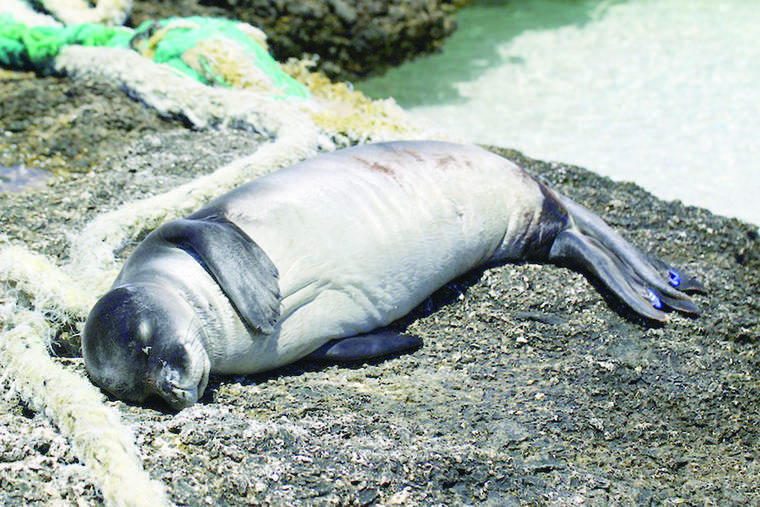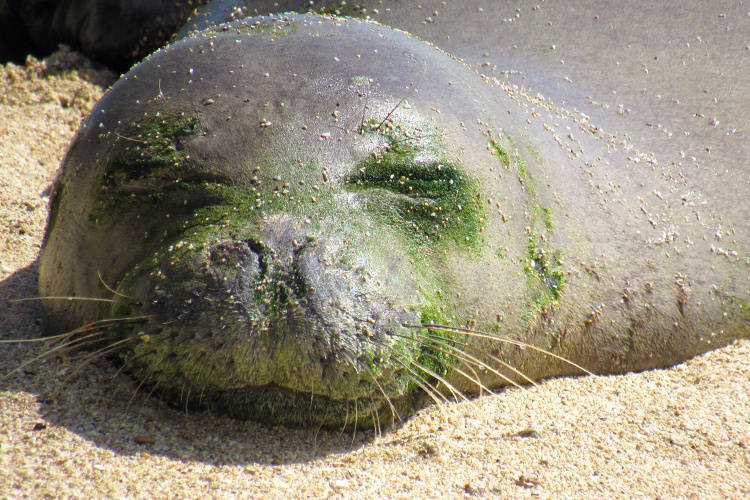The population of the endangered Hawaiian monk seal has risen an average of 2% per year since 2013, according to new figures that include totals for last year from the National Oceanographic and Atmospheric Administration.
However, the claimed rate of increase appears to conflict with the reality that, according to the same figures, the census actually dropped from 2018 to 2019.
More than that, the population also declined between 2016 and 2017. Asked specifically about trends on O‘ahu and Kaua‘i in the new NOAA statistical summary, the scientist who runs the seal program said the figures reflect “a slight increase.”
The summary was released on Thursday. The declines were from 1,417 in 2016 to 1,357 in 2017 and from 1,437 in 2018 to 1,428 last year. NOAA’s new figures showed that through the entire seven-year period in question, the aggregate total of Hawaiian monk seals rose from 1,290 in 2013 to 1,428 in 2019.
NOAA was not immediately able to explain the apparent discrepancies. “Communicating this type of statistical information is a common challenge in science communication,” said Ingrid Biedron, NOAA’s communications and public affairs officer in Honolulu. “We hope to provide information that helps communicate some of these nuances to the public.”
On Friday, several weeks after initial inquiries in late January, Biedron said the agency was still “working with our colleagues” to address the possible disparities, “due to the technical nature of these questions.”
The population of monks seals is far higher in the distant Northwest Hawaiian Islands than it is in the Main Hawaiian Islands. Since 2013, NOAA’s figures showed, the northwest islands’ population rose from 996 to 1,082, but there were also two years when it dropped in the same period. In the main islands, the population rose from 292 to 343, with only one year showing decline.
The Garden Island originally requested 10 years of statistics from NOAA, but the agency said it was unable to go back earlier than 2013 because it was “missing some key pieces of data.”
The observations that the seal population decreased between 2016 and 2017 and then between 2018 and last year were also consistent with a graphic distributed among monk-seal volunteer responders on Kaua‘i last October.
That summary said there were an estimated 67 monk seals in residence primarily on Kaua‘i in 2019, with six pups born here last year and at least one — but perhaps two — deaths. Five new seals were observed on Ni‘ihau in 2019 as well, the summary said.
Another 15 seals on Kaua‘i required rescue from “unsuitable locations” like boat ramps, beach roads and sidewalks. Six seals had to be retrieved from Po‘ipu Beach Park alone, the Kaua‘i summary indicated.
In all, the new NOAA figures indicate, the troubled seal species is not yet strong enough to give indications it may soon be removed from the endangered species list, though in 2015 the animal was shifted from the “critically endangered” category to merely “endangered.”
NOAA sidestepped a question about alterations in the monk-seal recovery budget under the Trump administration, saying support for Hawaiian monk seals increased in 2007 and has remained fairly consistent since then. That increase would have come under the administration of former President George W. Bush and remained flat under both Presidents Barack Obama and Donald Trump.
The agency did not assess the budget trends specifically under the Trump administration. But Trump’s budget proposal for 2019 originally included an 18% cut in NOAA’s climate- and ocean-research activities, as well as the agency’s broader education programs. NOAA did not respond to a followup question from The Garden Island about specific dollar amounts in the monk-seal budget this year or in any other year.
Despite Trump’s aversion to addressing climate change, NOAA insisted climate change remains a key threat to monk-seal survival.
Members of the public can report sightings of possibly troubled monk seals by calling 651-7668 on Kaua‘i or (888) 256-9840 statewide.
“Working with a small population of endangered animals that live across a very large geographic expanse is not a simple task,” said Stacie Robinson, the NOAA research ecologist for the monk-seal program, “but the Hawaiian monk-seal research program continues to study and monitor the population while also pushing the envelope on new technologies and emerging disease research.”
NOAA’s new summary also underscored how far the monk seal remains from population numbers that might assure the species’ survival. Robinson said the agency has “a recovery plan for Hawaiian monk seals that outlines criteria for down-listing from ‘endangered’ to ‘threatened.’”
To qualify for the less-drastic category, the monk-seal population would have to increase to at least 2,900 and remain there for at least 20 years, Robinson said, and the number of seals in the Main Hawaiian Islands would have to reach or exceed 500 throughout the same timeframe.
“This is one of the reasons threats like toxoplasmosis are so concerning. We need to remain strong in our recovery activities to build resilience in the population in the face of stressors like habitat loss and climate change.”
Toxoplasmosis is a parasitic infection that can be fatal to monk seals. In the Hawaiian Islands, cat feces washing from island land masses into the ocean is a key source of the disorder.
Robinson said various types of community support “play a huge role in the improvement we have seen in the monk-seal population.” She said an analysis completed several years ago showed that one of every three monk seals currently alive have benefitted from “some of our interventions, either saving that seal or its mother/grandmother.”
“Here in the main islands,” she said, “we couldn’t monitor the population without the support of the volunteer networks and public who report seal sightings. We also rely on the public to take simple actions that help protect monk seals, like fishing responsibly to prevent hookings or net entanglement, reporting accidental hookings immediately or keeping cats indoors to prevent toxoplasmosis.”




The seals are useless and creates a huge burden on local fisheries. I hope the toxoplasmosis makes a bigger impact on the seals soon!
Wowlaulau- based on what evidence. Old myth, let it go. You mean the occasional bait taken? Hook and line broken and lost? Same happens with sharks? That a burden? Seems more hard for seals with a hook. Or is it less fish. I agree less fish. That ain’t seals…it’s pollution, it’s development, it’s climate change and ocean warming. It’s too little managing the resource and letting too many people take too many fish. Like 10s of thousands of ya take too much. Or it’s the 300 seals..yeh no I don’t think it is the seals. Let’s look at is before we blame nature. Mahalos.
Yes, less fish due to seals. Do the math.